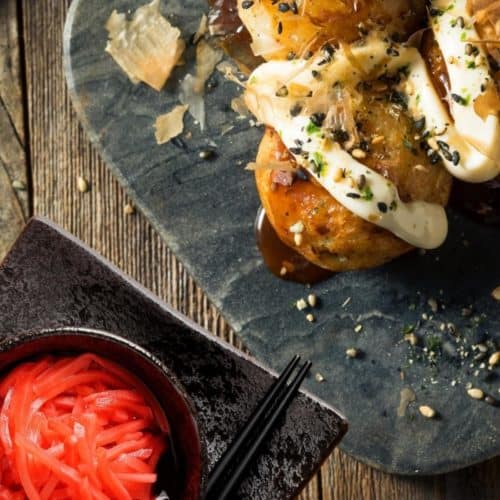Beni Shoga Takoyaki Recipe With Takoyaki Sauce
Adding beni shoga to your takoyaki filling will elevate the octopus and batter flavor to new heights. Everyone needs a little spice and acidity to activate that palate.
Servings 4 people
Cost $5
Ingredients
- 2 cups dashi
- 5 oz octopus (cooked and cubed, around 1/3-inch each)
- 2 large eggs
- 1 tsp soy sauce
- 2 green onions sliced
- ¼ tsp salt
- 1½ cups flour
- 2 tbsp beni shoga chopped (a type of red pickled ginger)
- takoyaki or okonomiyaki sauce (you might even get away with using tonkatsu sauce)
- 1 tbsp katsuobushi (dried bonito flakes)
- 1½ tsp Aonori green seaweed
- Japanese mayo
Instructions
- Get a large mixing bowl and whisk eggs, soy sauce, and salt together until it becomes vacuous.
- Place the takoyaki pan on the stove and brush it with light oil only in the holes, then heat it up until the oil starts smoking. Spread the oil using a brush thoroughly to coat the holes of the pan. This way, you'll keep the batter from sticking to the pan. After that, you may now pour the batter into the holes.
- While the batter is being cooked, drop the diced octopus meat in each hole, and then drizzle it with the chopped onions as well as the minced ginger throughout the takoyaki pan.
- Cook the takoyaki balls for about 1-2 minutes at medium heat and then flip them over using special takoyaki picks like these, bamboo or metal skewers, or even chopsticks. Cook the other half of the batter for another 3-4 minutes before transferring them to a clean plate and let cool.
- Once cooked, put them on a clean plate and pour the takoyaki sauce over them thoroughly, then add Japanese mayo to taste. To complete the dish and make them ready for serving, sprinkle it with green dried seaweed called “aonori” and dried bonito flakes called “katsuobushi.”
